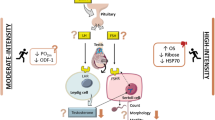Abstract
Research indicates that endurance-trained men have lower basal testosterone concentrations than age-matched sedentary control men. The physiological cause for this finding is uncertain. Therefore, we examined the peripheral component in the hypothalamic–pituitary–testicular (H–P–T) axis in endurance-trained men to determine if their basal testicular production of testosterone was compromised. The study design was retrospective, with a case-control approach. Age-matched, trained (n=5, TRN) and sedentary control men (n=6, SED) were infused with gonadotrophin-releasing hormone (GnRH) to induce testicular testosterone production via subsequent luteinizing hormone elevations. Testosterone production rate was statistically analyzed with adjustments for confounding factors and compared between groups. The basal testosterone concentrations differed significantly between the TRN and SED groups [pooled mean values; 13.9 (3.0) nmol·l−1 vs 23.4 (3.2) nmol·l−1, P<0.05]. The testosterone production rate was significantly lower (~20–30%; P<0.05) in the TRN men as compared with the SED men following GnRH infusion. It was concluded that the exogenous stimulated testicular production rate of endurance-trained men is suppressed. This finding may account, in part, for the lower circulating basal testosterone concentrations found in these men. The present evidence supports the hypothesis that endurance exercise training induces a degree of peripheral adaptation (i.e., testicle) in the H–P–T axis. Whether this adaptation in the axis is a permanent or transient phenomenon in these men remains to be determined.

Similar content being viewed by others
References
Ayers JWT, Komesu V, Romani T, Ansbacher R (1985) Anthropomorphic, hormonal, and psychologic correlates of semen quality in endurance-trained male athletes. Fertil Steril 43:917–921
Bardin CW (1978) Pituitary–testicular axis. In: Yen SSC, Jaffe RB (eds) Reproductive endocrinology; physiology, pathophysiology and clinical management. Saunders, Toronto, pp 110–125
Cohen J (1988) Statistical power analysis for the behavioral sciences, 2nd edition. LEA Publishers, New Jersey, pp 16–72
Gulledge TP, Hackney AC (1996) Reproducibility of low testosterone concentrations in endurance trained men. Eur J Appl Physiol 73:582–583
Hackney AC (1996) The male reproductive system and endurance exercise. Med Sci Sports Exerc 28:180–189
Hackney AC, Sinning WE, Bruot BC (1988) Reproductive hormonal profiles of endurance-trained and untrained males. Med Sci Sports Exerc 20:60–65
Hackney AC, Sinning WE, Bruot BC (1990) Hypothalamic–pituitary–testicular axis function in endurance trained males. Int J Sports Med 11:298–303
Kujala UM, Alen M, Huhtaniemi II (1990) Gonadotrophin-releasing hormone and human chorionic gonadotropin test reveals that both hypothalamus and testicular endocrine functions are suppressed during acute prolonged physical exercise. Clin Endocrinol 33:219–225
MacConnie SE, Barkan A, Lampman RM, Schork M, Beitins IZ (1986) Decreased hypothalamic gonadotropin-releasing hormone secretion in male marathon runners. N Engl J Med 315:411–416
McConnell T, Sinning WE (1984) Exercise and temperature effects on sperm production and plasma testosterone levels in humans. Med Sci Sports Exerc 16:51–55
Wheeler GD, Wall SR, Belcastro AN, Cumming DC (1984) Reduced serum testosterone and prolactin levels in distance runners. JAMA 252:514–516
Wheeler GD, Singh M, Pierce WD, Epling WF, Cumming DC (1991) Endurance training decreases serum testosterone levels in men without change in luteinizing hormone pulsation release. J Clin Endocrinol Metab 72:422–425
Author information
Authors and Affiliations
Corresponding author
Rights and permissions
About this article
Cite this article
Hackney, A.C., Szczepanowska, E. & Viru, A.M. Basal testicular testosterone production in endurance-trained men is suppressed. Eur J Appl Physiol 89, 198–201 (2003). https://doi.org/10.1007/s00421-003-0794-6
Accepted:
Published:
Issue Date:
DOI: https://doi.org/10.1007/s00421-003-0794-6




